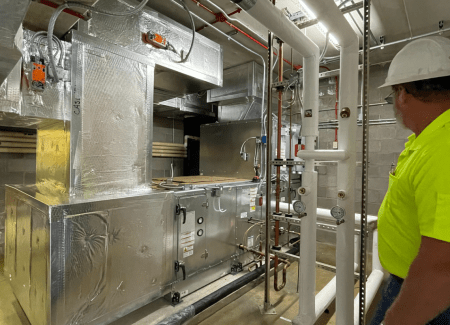Some may regret the passing of summer, but for many who are confined in North Carolina’s prisons, it could bring a sense of relief — especially for those incarcerated in buildings without air conditioning.
While it might be a natural inclination to write off this summer’s extreme heat as an anomaly as autumn brings chillier weather across the state, scientists and researchers have cautioned otherwise. Ashley Ward, director of the Heat Policy Innovation Hub at Duke University, said several months ago that the season of record-breaking heat in 2023 could be the “coolest summer for the rest of our lives.”
Such assertions have prisoner advocates from across the country — particularly in the South and Southwest — decrying the sweltering conditions in which some inmates are forced to live.
Temperatures rose into the high 80s and 90s in some of the North Carolina prisons that lack cooling systems, and some inmates would soak their clothes in the showers so they could cool down enough to sleep.
Despite the well-documented problems and lawmakers’ promises to bring relief, North Carolina has been slow to get air conditioning throughout a prison system that houses more than 31,000 inmates. That could mean people incarcerated in uncooled facilities face dangerous heat-related health risks.
Exposure to extreme heat can exacerbate cardiovascular problems and can increase the risk of death from heart and lung conditions. Being too hot can lead to dehydration, which can, over time, result in low blood pressure and decreased kidney function. Older people and people with chronic health conditions are at greater risk.
In the works in North Carolina
In North Carolina, an effort has been underway to design and install air-conditioning systems in 40 state prisons, using $30 million appropriated by the General Assembly in 2021. Some of those prisons had no cooling systems, and some were only partially cooled.
The goal is to complete the upgrades in 148 buildings by 2026, according to the N.C. Department of Adult Correction.
Despite some progress, family, friends and advocates for North Carolina inmates expressed concern this summer that more headway had not been made, especially at the North Carolina Correctional Institution for Women in Raleigh.
The women’s prison is one of the larger projects, and work on it has been broken into three phases.
John Bull, a spokesperson for the prison system, provided an update to NC Health News last week in an email. At some of the prisons, inmates are helping with the construction work, but that is not the case at the women’s prison.
Project bids that had been opened Oct. 24 were being evaluated, he said. It’s not clear when construction would begin if the bids are accepted or if the work would be done by next summer.
A project at Caswell Correctional Institution to cool 72 beds was completed in June, according to Bull. A project at Harnett Correctional Institution that includes 246 beds, another at Caswell Correctional Institute for 127 beds and one at Albemarle Correctional Institute for 269 beds are expected to be done this fall.
Air-conditioning projects at those three prisons, as well as at Dan River and Orange correctional facilities are being worked on by inmates enrolled in the Construction Apprenticeship Program, according to Bull.
A private contractor is working on a project at Sampson Correctional Institution, he added.
In all, projects were in the works across the prison system to cool 3,000 beds.
“As you know, a number of these prisons are quite old,” Bull said in his email to NC Health News, noting that the women’s prison facilities date “from before World War II.”
“They weren’t built with air-conditioning systems or designed to accommodate air-conditioning systems,” Bull added. “Some retrofitting is necessary for the accommodation of air-conditioning systems at some of the prisons slated for air-conditioning installation. This is a major initiative, which as you can see, is moving forward expeditiously despite its complexities.”

Congressional attention to hot prisons
A Prison Policy Initiative blog post this summer noted results of an epidemiological study that found a “strong relationship between extreme heat and deaths in prisons.”
In August, 14 Democratic members of Congress wrote to the chairman of the Committee on Oversight and Accountability in the U.S. House of Representatives to demand attention to such circumstances after a sharp increase in Texas prison death rates that were believed to be heat-related.
“Most states do not provide air conditioning or adequate ventilation in prisons to withstand heat emergencies, posing serious risks to both incarcerated individuals and staff,” the Democratic representatives wrote in their correspondence to U.S. Rep. James Comer, the Kentucky Republican who leads the committee.
They invited Republicans on the committee to join Democrats in a bipartisan investigation of the conditions of prisons and jails across the country, including the strategies that states are using to keep inmates and staff safe during such extreme heat seasons.
“Our planet recently experienced the hottest month ever recorded, with Texas and other southern states measuring some of the hottest temperatures on Earth,” they added. “The capacity of prisons and jails to adequately prepare for and provide resources to meet the increasingly extreme weather caused by climate change deserves immediate attention from this Committee.”
This article first appeared on North Carolina Health News and is republished here under a Creative Commons license.![]()
This post was originally published on this site be sure to check out more of their content.








